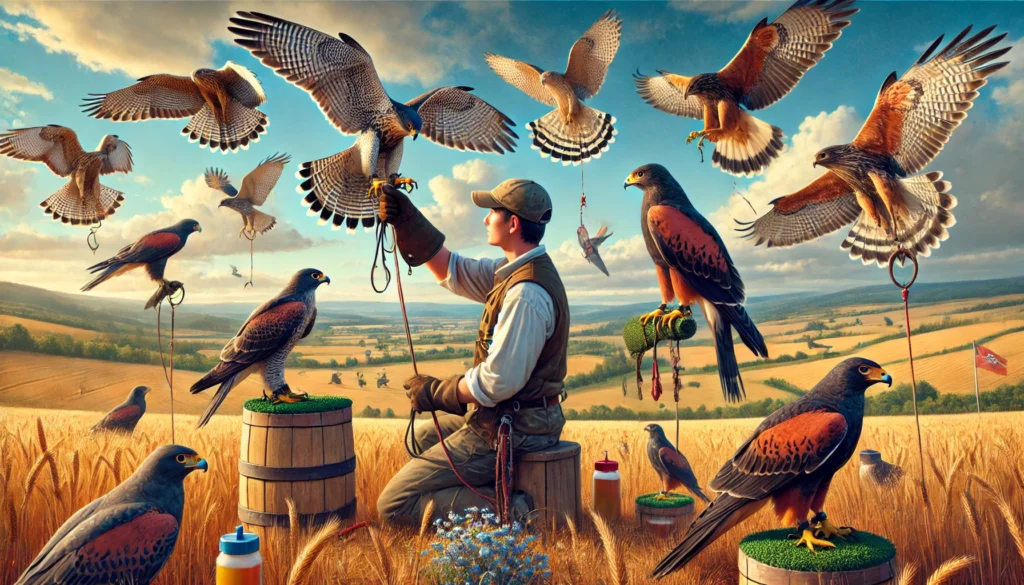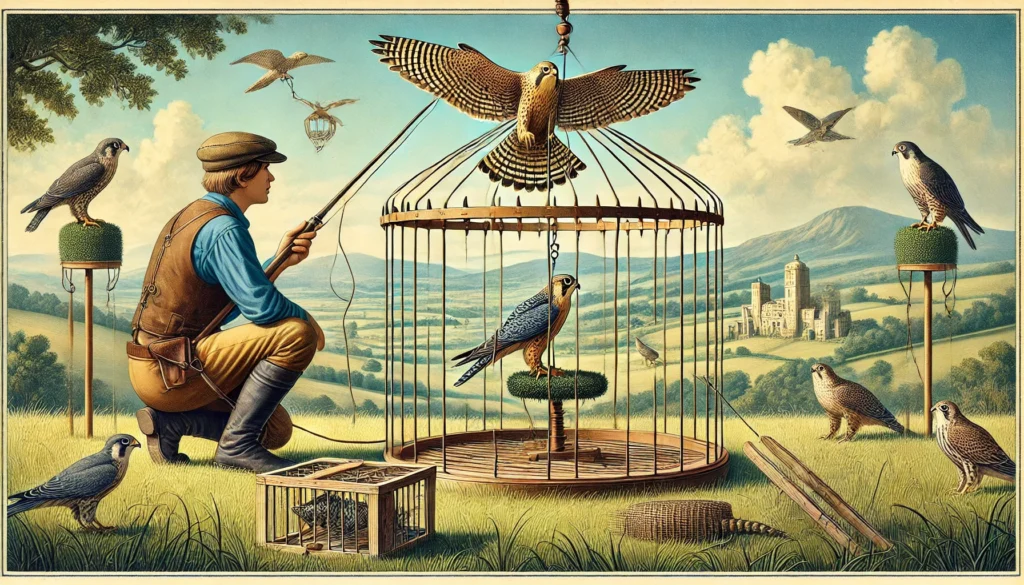Essential Insights on Jesses and Leashes for Falconry
- Purpose and Safety: Jesses and leashes are vital for controlling and ensuring the safety of birds of prey in falconry.
- Material Choices: Jesses can be made from leather, kangaroo hide, synthetic rope, or paracord, each offering different benefits in terms of durability and comfort.
- Attachment Methods: Jesses are attached to the bird’s legs through anklets or cuffs, which must be carefully fitted to avoid injury.
- Length and Design: The length and design of leashes vary based on the bird’s size and species, ensuring they can move freely but remain controlled.
- Weight Consideration: Lightweight materials for jesses and leashes prevent added stress and fatigue for the falcon.
- Quick-Release Mechanisms: Quick-release mechanisms are essential for the safety and rapid response during flight training or emergencies.
- Maintenance and Inspection: Regular inspection and maintenance of the jesses and leashes are crucial to prevent wear and tear that can lead to accidents.
These insights help falconers choose the right equipment, ensuring the well-being and effective training of their birds.
The Importance of Jesses and Leashes in Falconry: An Irish Tale
At Learn Falconry, we believe that understanding jesses and leashes ‘ those little leather wonders ‘ is just as essential for falconry as a shepherd’s whistle is for controlling his dog. These tools do more than just keep your raptor close; they allow for a connection between you and your bird that is based on trust and respect. Without proper understanding and use of jesses and leashes, the harmony of this ancient practice could be disrupted, leaving you and your feathered companion lost at sea like an Irish fisherman without his compass.
So pull up a seat and get ready to explore how jesses and leashes ensure not only the safety but also the ultimate success of your falconry endeavors. Trust us, it’s a tale worth telling and an article worth reading ‘ for it’ll make you a better falconer and a true friend to your avian ally. Sláinte!
Understanding Falconry Jesses and Falcon Leashes
Falconry jesses and falcon leashes are essential pieces of falconry equipment used by falconers to handle their birds safely. These tools allow a falconer to have control over their bird, ensuring both safety and training efficiency.
What Are Falconry Jesses?
Falconry jesses are thin straps, usually made of leather, that are attached to the legs of a falcon or other bird of prey. These straps provide a way to hold onto the bird without harming it. Falconry jesses have been used for centuries and are an important part of a falconer’s toolkit. They are typically attached through small holes in the anklets that are worn by the bird.
For more information about the history and importance of falconry equipment, visit our History of Falconry page.
Types of Falconry Jesses
There are different types of falconry jesses, including:
- Traditional Jesses: Made of leather, these are the most common type used historically.
- Modern Jesses: These may be made from synthetic materials which can offer benefits such as increased durability and weather resistance.
Each type serves the same basic function but may be chosen based on the specific needs of the bird and the falconer.
Falcon Leashes
Falcon leashes are used to secure the bird to a perch or a falconer’s glove. They are attached to the jesses and allow the falconer to have control over the bird when it is not flying.
Leashes come in various designs and materials, often consisting of a swivel to prevent twisting, which can be uncomfortable or even injurious to the bird. Like jesses, leashes are a crucial component of falconry equipment, aiding in the bird’s training and day-to-day management.
Find out more about different falconry equipment on our Falconry Equipment page.
The Importance of Quality Equipment
Using high-quality jesses and leashes ensures the safety and comfort of the falcon. Poorly made equipment can lead to injuries or escape, which is why it’s important to invest in good gear.
Understanding how to properly use these tools is also key. Training and experience play a significant role in the effective and humane use of equipment in falconry.
For those new to the sport, familiarizing yourself with falconry techniques can be beneficial. Learn more at our Falconry for Beginners section.
Training with Jesses and Leashes
Training a falcon involves using jesses and leashes during initial stages to build trust and ensure control. They are instrumental in recall training, where the bird is taught to come back to the falconer. This foundational training is crucial for more advanced falconry techniques.
To delve deeper into training methods, consider exploring our Training a Falcon resources.
Safety Considerations
Proper care and maintenance of jesses and leashes are essential for the bird’s safety. Regular checks for wear and tear can prevent accidents. Additionally, understanding the legal aspects of falconry, including rules around the use of equipment, is critical.
For a comprehensive guide on legal requirements in falconry, visit Legal Aspects of Falconry.
Conclusion
Investing in quality falconry jesses and falcon leashes is paramount for both beginner and advanced falconers. These tools not only aid in training and control but also ensure the well-being of the bird. Understanding their types, uses, and maintenance can significantly enhance your falconry experience.
For more in-depth information on specific equipment and techniques, feel free to explore our other resources:
Understanding Falconry Jesses and Leashes in 2024
Falconry is an ancient and fascinating sport, and equipment like jesses and leashes are essential for ensuring both the safety of the bird and effective handling by the falconer. Let’s delve into the specifics of these crucial components in 2024.
Jesses: The Key to Bird Control
What Are Jesses?
Jesses are leather straps of equal length that are fastened around the legs of a hawk or falcon. They allow the falconer to retain control of the bird on the gloved fist before it is fully trained or when it is away from the hunting ground.
Purpose and Use
- Training: Jesses play a pivotal role in training hawks and other birds of prey. They help maintain control and facilitate handling, particularly during the initial stages of training.
- Flying and Hunting: Different designs for jesses are used when perching or during flight and hunting activities.
Example Data
Here’s a simple table showcasing the types of jesses used for different birds:
| Bird Species | Jesses Type | Material |
|---|---|---|
| Peregrine Falcon | Perching Jesses, Hunting Jesses | Leather |
| Red-tailed Hawk | Training Jesses, Perching Jesses | Kangaroo Leather |
| Gyrfalcon | Flying Jesses, Perching Jesses | Nylon |
Leashes: Ensuring Strong and Safe Tethering
Materials
Leashes in 2024 are often made from durable materials such as Dacron, nylon, and leather. These materials are selected for their strength, resistance to weather conditions, and ease of maintenance.
Design and Construction
- Anti-Tangle Design: Modern leashes are designed with braided or round braided designs to prevent tangling and ensure smooth movement.
- Strength and Sturdiness: The construction of leashes focuses on maintaining strength and durability.
Sizes and Lengths
Leashes come in various sizes and lengths to accommodate different bird species. For instance:
- Small Birds: Leashes for birds like merlins are shorter and lighter.
- Larger Birds: Larger and stronger leashes are needed for birds such as eagles.
| Bird Size | Suggested Leash Length |
|---|---|
| Small (Merlins) | Up to 2 feet |
| Medium (Hawks) | 2 to 3 feet |
| Large (Eagles) | 3 to 4 feet |
Features and Accessories
Leashes often include additional features to aid in handling and tethering:
- Clips, Swivels, and Snaps: These features facilitate easy attachment and detachment.
- Bungee Cords: Optional accessories for added flexibility and comfort.
- Modified Fox Loops: Provide additional versatility for different tethering situations.
Customization
Many suppliers offer custom-made leashes to meet specific falconer needs. Options include different materials, sizes, colors, and features to suit individual training styles.
Maintenance and Care
Proper care and maintenance are essential for extending the life of a falconry leash. This includes:
- Regular Cleaning: Frequent cleaning to remove dirt and grime.
- Conditioning: Using leather conditioners to maintain flexibility and prevent cracking.
- Inspection: Regularly checking for any signs of wear and tear to ensure safety.
By understanding and utilizing the right jesses and leashes, falconers can ensure a safer and more effective experience for both themselves and their birds.
Wrapping Up: Your Guide to Jesses and Leashes in Falconry
Jesses and leashes are essential tools in the world of falconry, playing a crucial role in training and handling birds of prey. Jesses are durable leather straps used to control and secure hawks, allowing falconers to interact with their birds safely. Leashes, designed from robust materials like Dacron, nylon, and leather, ensure the secure tethering of various bird species, from small merlins to large eagles.
In 2024, advancements in falconry equipment emphasize durability, customization, and ease of use. Modern leashes feature anti-tangle designs and come with convenient accessories like clips and swivels. Jesses, on the other hand, continue to be a fundamental part of falconry, facilitating control during training sessions and ensuring the bird’s safety when not in flight.
Maintaining your equipment through regular cleaning and conditioning ensures longevity and reliability. Whether you’re a seasoned falconer or a novice, understanding the proper use and care of jesses and leashes is key to a successful and rewarding falconry experience.
We hope this guide has equipped you with valuable insights into the world of falconry jesses and leashes. Here’s to many safe and successful flights with your feathered companions!



